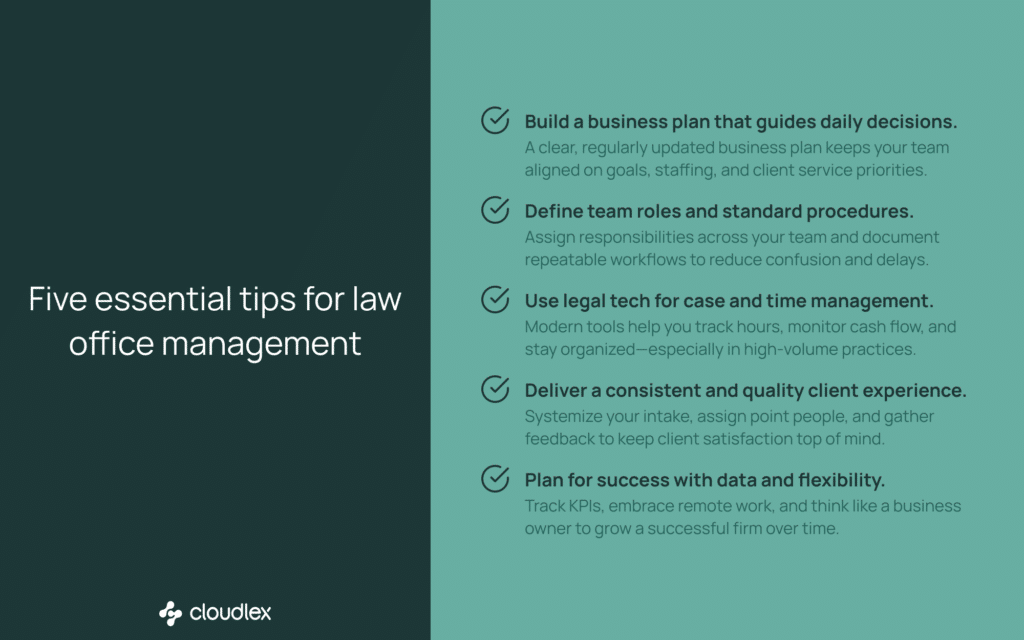Running a personal injury law firm goes far beyond courtroom strategy. It’s about leading a business—managing staff, serving clients, and building systems that support long-term success.
Whether you’re the managing partner of a growing team or running a small law firm, this guide will walk you through best practices in modern law firm management—including people, procedures, performance, and planning for long-term success. Let’s make your firm work smarter, not harder.

Contents
1. Lay the groundwork for smooth law firm management
A strong firm starts with a strong foundation. That means clear leadership, organized processes, and systems that support your people and your clients.
Create a useful law firm business plan
Your business plan should guide your hiring, client acquisition strategy, budget, and overall vision. Keep it simple. Include:
- How your firm will attract new clients
- How you’ll deliver consistent, high-quality client service
- Your approach to managing cash flow in a contingency-based model
- Short- and long-term goals for sustainable growth
Revisit and update your plan quarterly to stay aligned with your firm’s evolving needs.
Define roles across your law office
Every team member should know their core responsibilities. For example:
- Office managers keep your law office running day-to-day
- Legal assistants handle document prep, filing, and intake
- A chief operating officer (COO) helps streamline operations so leadership can focus on growth
- The managing partner sets direction and keeps everyone accountable
When roles are clear, work flows smoothly—and client communication improves naturally.
Invest in your people with HR and professional development
A strong human resources strategy helps your firm create a culture of support, accountability, and growth. This means setting up:
- Structured onboarding checklists for new hires
- Goal-setting sessions that align team members with firm priorities
- Ongoing training and performance evaluations
These systems not only promote professional development but also boost morale, reduce turnover, and build a high-functioning legal team.
Standardize your client intake and communication process
A consistent client intake and communication strategy helps set expectations and reduce confusion from the start. Here’s how to build one:
- Use templated forms to simplify and speed up intake
- Track inquiries and status updates through your case management system
- Assign a dedicated point of contact, like a legal assistant, to every client
Follow up early and often—your client communication style should reflect your firm’s values from the very first interaction.
Support law students through externship opportunities
Many law schools now require an externship as part of their curriculum—your firm can use this as a chance to engage with new talent early.
Offer structured, hands-on experiences and mentorship. Students gain valuable exposure, and your firm builds future hiring opportunities while giving back to the profession.
2. Use tools and metrics to run a more efficient firm
Running a law office without systems is like arguing in court without evidence—risky and unnecessary. With the right tools and key performance indicators, your firm can grow sustainably.
Track team productivity and performance effectively
In a contingency fee model, time still matters—even if you’re not billing hourly. Understanding how your team spends their time helps you:
- Identify bottlenecks and delays in case progress
- Balance workloads across attorneys and staff
- Evaluate time-to-resolution for various case types
Use your case management tools to monitor productivity and adjust staffing or resources as needed.
Streamline case management
If your team is juggling emails, spreadsheets, and post-its, it’s time for an upgrade. A reliable case management tool should let you:
- Organize files and deadlines
- Track communications
- Automate reminders
- Collaborate across remote or hybrid teams
Monitor cash flow weekly
Poor cash flow can cripple even a busy firm. Make it a routine to:
- Track accounts receivable and expenses
- Set reminders for follow-ups on outstanding payments
- Evaluate case costs vs. projected returns
Work with your chief financial officer or accountant to stay on top of it.
Set KPIs that matter to your practice
Decide what success looks like for your firm—and then track it regularly. The right key performance indicators (KPIs) can show where you’re excelling and where you need to make adjustments. For personal injury practices, consider monitoring:
- Number of intakes/matters created each month: Helps you understand demand and evaluate the effectiveness of your client acquisition efforts.
- Number of matters closed each month: Reveals your team’s case resolution pace and helps plan future workload and staffing.
- Average settlement value per matter: A core metric for contingency-based firms that helps assess overall case quality and profitability.
- Client satisfaction score or feedback rating: Shows how well your client service process is working from intake to resolution.
By tracking KPIs that reflect your actual business model, you’ll be able to make informed decisions and grow a more successful firm.
3. Make your client experience a competitive advantage
In personal injury law, client satisfaction is often the difference between a referral and a bad review. Make it your firm’s secret weapon.
Create a consistent, repeatable client service process. Your client management approach should feel personalized—but behind the scenes, it should be systematized. Use a checklist that includes:
- Intake confirmation
- Regular status updates
- Milestone alerts (ex: when discovery begins)
- Post-resolution follow-up
This builds trust—and keeps your staff members aligned.
Improve client satisfaction with feedback loops
After a case closes, ask your clients how it went. You can use:
- Short surveys
- Review requests
- Personalized thank-you emails
Learning from client feedback helps improve your client service and stand out in the legal industry.
Assign point people to improve communication
When clients don’t know who to call, frustration grows. Assign each client a dedicated legal assistant or paralegal. This person should:
- Answer routine questions
- Relay updates
- Log communications in the system
It’s simple—and it reduces stress for everyone.
Invest in marketing that brings in the right clients
If you want to grow, clients need to be able to find (and trust) your firm. Here’s a simple framework your staff can follow to deliver consistent service every time:
- Build a well-optimized website to drive traffic through local SEO and organic search
- Use digital marketing, including paid search, social media, and remarketing, to generate quality leads
- Consider strategic outdoor advertising, like billboards and transit ads, to boost visibility in your community
- Keep your firm’s online directory listings accurate and up to date across platforms like Google, Avvo, and Justia
Marketing doesn’t have to be complicated—but it does need to be consistent. The more places potential clients see your name, the more likely they are to call.
4. Follow best practices while planning for the long term
No matter how busy your law firm is today, you need to think ahead. Long-term success means anticipating change and building systems that can scale with you.
Support remote work with clear expectations
If your firm allows remote work, make sure your team knows what is expected. That includes:
- Defined work hours and availability
- Agreed-upon communication tools and check-in routines
- Clear security protocols for handling sensitive information
Use collaboration tools and cloud-based case management software to keep your team connected, organized, and accountable—wherever they’re working from.
Systematize your law office operations
Strong firms run on clear processes. Start building structure into your daily operations by:
- Writing down your best practices
- Creating a law office procedures manual
- Standardizing everyday tasks like file naming, onboarding new clients, and closing matters
When your systems are repeatable and teachable, your firm can grow without chaos.
Lead with strategy and financial clarity
Great leadership is intentional. Your leadership team should meet regularly to align key business decisions. Focus on:
- Revenue goals, based on real data and long-term targets
- Staffing needs, based on case volume and productivity
- Risk areas, like compliance gaps or slow case resolution
- Opportunities to invest—whether it’s new tech, marketing, or talent
The more clearly you plan, the more confidently your firm can grow.
5. Make the shift from law practice to law business
Legal skill is one piece of running a thriving firm. Systems, people, finances, and client experience matter just as much.
Run your firm like a business, not just a practice. Start thinking like an entrepreneur. Set business goals. Track data. Reward performance. Standardize tasks. Delegate effectively.
That shift in mindset is what separates busy firms from profitable ones.
Adopt tech made for personal injury firms
If you’re ready to streamline your processes and get better visibility into your operations, CloudLex can help.
CloudLex is legal practice management software built specifically for personal injury law firms. It’s designed to support case management, client intake, document storage, workflow automation, and task tracking—all tailored to the personal injury space.
With cloud-based access, simple dashboards, and integrations that help your team stay on the same page, CloudLex helps firm owners run their legal services like a business.
You handle justice—we’ll help you handle everything else.

